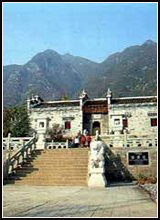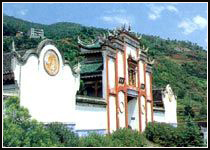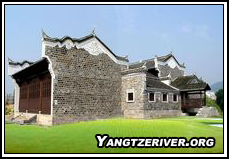Zigui Travel Guide
Introduction
Zigui is a county in Hubei province. It locates at the exit of Xiling Gorge, and the joints of the Xiangxi and Yangtze River. It was tZhaojun's Hometown, Ziguihe hometown of Qu Yuan, a great poet and politician of the State of Chu in the Warring States Period (475-221 B. C.). Qu Yuan, as the story goes, threw himself into the river in order to protest against the tyrannical King of the ChuState. To memorialize him, a museum has been built outside the east end of the county seat.
This structure was built during the Tang Dynasty (618--907). The stone figure of the poet is displayed here. Other spots include Qu Yuan Temple, Qu Yuan Tomb, etc. Anothrer way is to dropp zongzi, glutinous rice dumplings, into the water in the wish that fish would feast on the zongzi rather than on Qu. Over the years, this has gradually evolved into the Dragon Boat Festival with people eating zongzi on the day.

Today, the dragon boat racing and eating zongzi have been a tradition for worldwide Chinese people, and the people in the South East Asia.
Tourists will join a boat racing here when the ships stop at Zigui for shore excursions.
One may also take a dragon boat in the Fragrant Stream and see the native town of Wang Zhaojun (see "Xingshan County"), a famed beauty in ancient Chinese history, who was sent by the king to marry a Hun Chief to establish peace.
What to see
Quyuan Shrine
Qu Yuan Shrine was built in memorial of the great patriotic poet Qu
Yuan(339?BC~278?BC). It is situated at Quyuan Shrine, ZiguiXiangjiaping,
1.5km from Guizhou Town, the seat of Zigui County.In 820, the Qu Yuan
Shrine was built at Quyuantuo, 2.5 km from the county seat. After that
it was rebuilt many times. Because of the construction of the Gezhouba
Water Control Project, the water level rose, the shrine was rebuilt at
the eastern suburb of the county. The three Chinese characters "Qu Yuan
Shrine "were inscribed by Guo Moruo (1892―1978, an outstanding
contemporary Chinese historian, paleographer and play wright).
 Seventy-seven
kilometres upstream from Yichang City lies the mouth of the Xiangxi
River on the north bank of the Yangtze. Nearby was Zhaojun's Hometown.
In her hometown, there are many beautiful stories about Wang Zhaojun,
one of the four Chinese greatest beauties. It is said once when Zhaojun
was washing her face in the river, a string of pearls of her ornaments
fell into the water. Ever since then, the river water carried the scent
like that of perfume. Xiangxi River boasts the Peach Blossom Fish, a
rare and protective species.
Seventy-seven
kilometres upstream from Yichang City lies the mouth of the Xiangxi
River on the north bank of the Yangtze. Nearby was Zhaojun's Hometown.
In her hometown, there are many beautiful stories about Wang Zhaojun,
one of the four Chinese greatest beauties. It is said once when Zhaojun
was washing her face in the river, a string of pearls of her ornaments
fell into the water. Ever since then, the river water carried the scent
like that of perfume. Xiangxi River boasts the Peach Blossom Fish, a
rare and protective species.
Transparent and creamy coloured, it is shaped like an umbrella. Legend tells that, after a home visit, Zhaojun started on her trip beyond the Great Wall to be married to the Xiongnu chieftain. As she sailed along the river, her tears dropped into the water to mingle with the floating peach blossom and turned into beautiful fish. Wang Zhaojun was born in Baoping Village whose original name was Yandunping, or Wangjiawan, 5.5 km from Xingshan County. There are some sites in Zhaojun's hometown, such as Dressing Table, The Well of the Nanmu Tree, ZJiangdu, Templehaojun's Shrine, Zhaojun's Residence, etc. In 1979, Zhaojun's Residence was rebuilt.
Jiangdu Temple
 Jiangdu
Temple used to be the place where the ancestors offer their sacrifices
to the god of the Yangtze. It was originally built in Guilin valley,
Xintan town, nearly one thousand year ago. The current structure has a
history of more than 200 years. It was rebuilt in the year of 2002 on
the top of Fenghuang (Phoenix) Mountain, new Zigui County. Jiangdu
Temple is one of the typical examples of the local architecture which
merges the north official architecture pattern and the south delicate
workmanship together. It is seldom seen among the numerous cultural
relics unearthed in the Three Gorges region.
Jiangdu
Temple used to be the place where the ancestors offer their sacrifices
to the god of the Yangtze. It was originally built in Guilin valley,
Xintan town, nearly one thousand year ago. The current structure has a
history of more than 200 years. It was rebuilt in the year of 2002 on
the top of Fenghuang (Phoenix) Mountain, new Zigui County. Jiangdu
Temple is one of the typical examples of the local architecture which
merges the north official architecture pattern and the south delicate
workmanship together. It is seldom seen among the numerous cultural
relics unearthed in the Three Gorges region.



